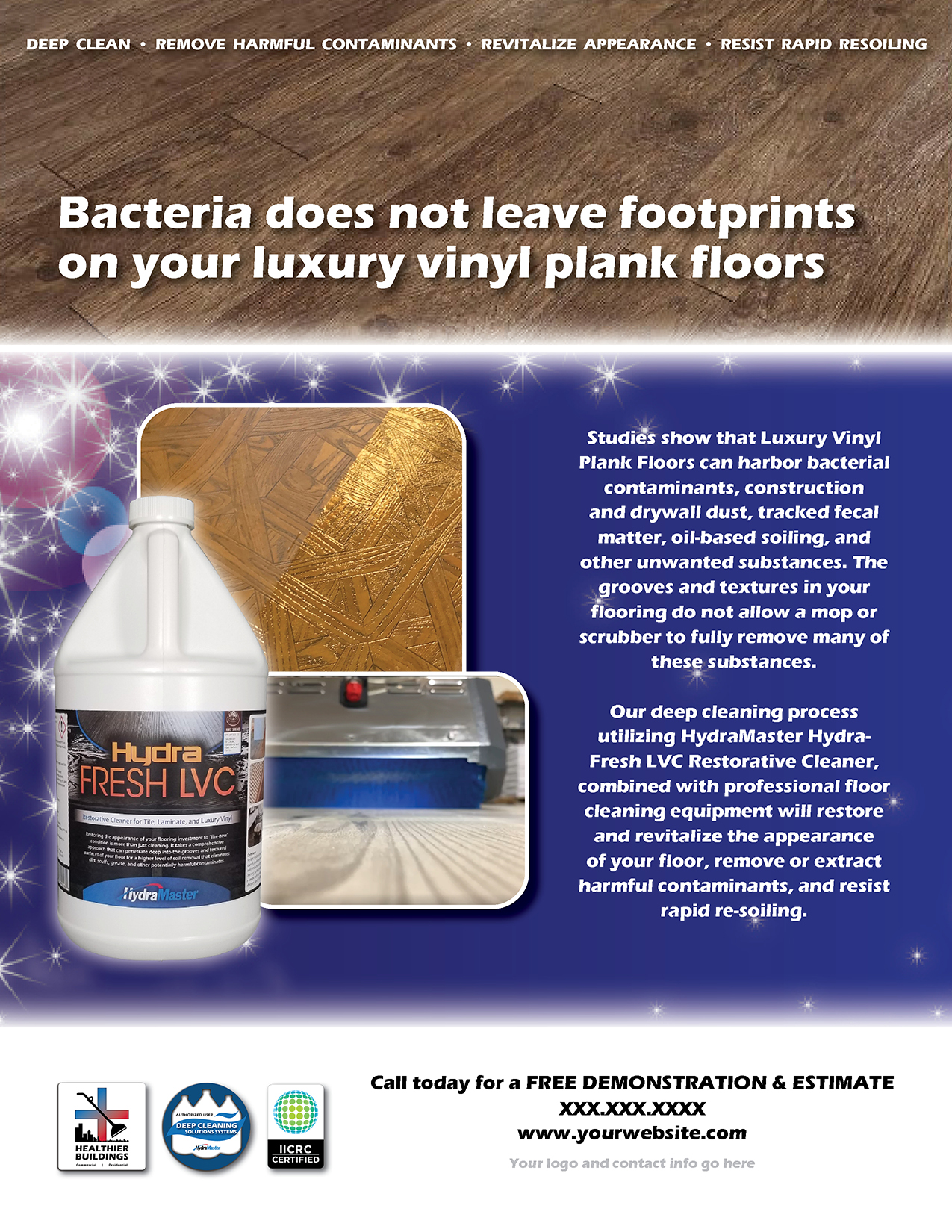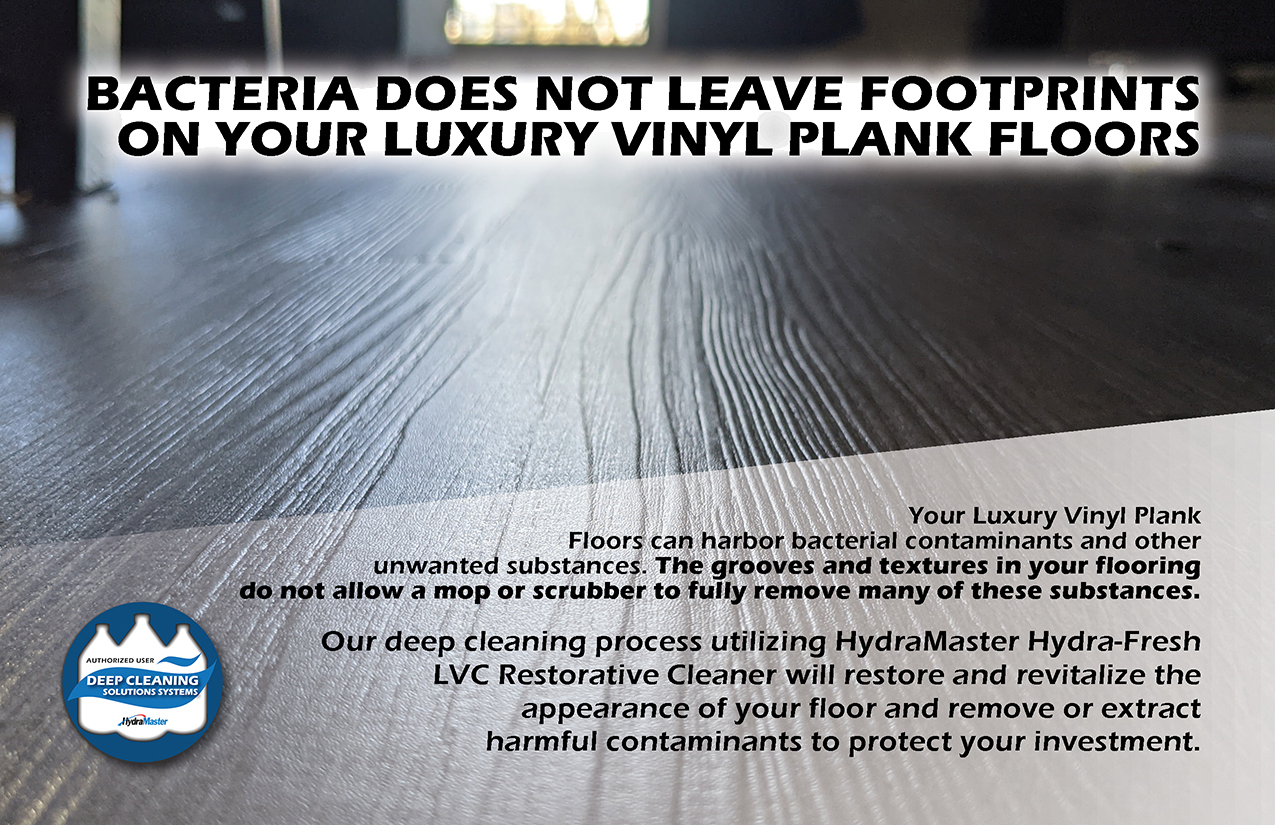Help your customers get their groove back by restoratively cleaning their luxury vinyl plank floors
You Should Have Already Noticed the Unprecedented Rise of Luxury Vinyl Plank Floors
While the global pandemic halted the sales growth of most flooring materials, Luxury Vinyl plank (LVP) continued its historic rise, growing 21.3% over 2019 in 2020 (According to Floor Covering News, May 10/17, 2021). It continues to be the fastest growing floor covering material. At first glance to the professional carpet cleaning, the meteoric rise in the market share growth of LVP floors may not present an immediate obvious opportunity. After all, with the numerous benefits of LVP (water resistant, stain resistant, easy to install, less expensive, etc.) the first impression of most homeowners is that they can easily clean these floors themselves. Whether they are using a Swiffer®, a mop and bucket, or a hard surface floor steamer or cleaner, they can pretty much convince themselves that the floor looks clean. A deeper dive into reality though starts to unlock some often-overlooked challenges and pitfalls.
Can Your Customers Hard Surface Floor Look Clean but Still Be “Dirty?”
LVP and laminate floors may look cleaner, but now we are beginning to understand better that they also need to also be free of unwanted matter – soil, germs, bacteria, and viruses. When you really start to look at the cleaning tools or procedures employed by most homeowners, most hard surface floor cleaning is just as much about soil-rearrangement as it is about soil removal. In fact, studies show that wiping or mopping a hard surface floor can spread as many contaminants as they remove. In a series of studies and research paper conducted or sponsored by KaiVac® Cleaning Systems, a strong conclusion was reached: “Science has now proven what many cleaning professionals have suspected for years: wiping surfaces such as desks with rags, sponges, and conventional cleaning cloths as well as mopping floors with string mops and buckets can spread as many contaminants as they remove. In fact, scientific studies have concluded that the last surface cleaned with a conventional cleaning cloth, which is usually a terry cloth towel, may have two to as much as eight times more soil on it than the first surface cleaned with the towel.”
A” Reservoir” of Microbes?
In fact, clean looking floors have been found in studies to often be a reservoir of microbes. In one study published by the International Journal of Environmental Research and Public Health, they summarized their findings: “our exploratory study found that the floor surfaces tend to be heavily colonized by bacteria, especially soilborne bacteria. There was not much apparent difference in bacterial composition between the buildings or floor types, but traffic level plays a significant role in influencing on bacterial abundance and community. Fecal contamination was prevalent on the floor surfaces, especially dog-specific fecal bacteria.” Another study done by Charles Gerba, a University of Arizona microbiologist found that “Over 90% of fecal matter that shoes pick up in public restrooms and from animal fecal matter outdoors has been shown to transfer to hard surface floors throughout a facility.” Dr. Gerba continued: “I’m starting to make myself paranoid,” Gerba told the Baltimore Sun when his study debuted in 2008. “It seems like we step in a lot more poop than I thought.” For the study, 10 people wore brand-new shoes for two weeks before their kicks were sampled for bacteria. The outside of the shoes averaged 421,000 units of bacteria, compared with 2,887 on the inside. And fecal bacteria appeared on 96% of the shoes. Those fecal bacteria “indicates frequent contact with fecal material, which most likely originates from floors in public restrooms or contact with animal fecal material outdoors,” Gerba said for the study. And here’s the, ahem, kicker: The transfer rate bacteria from shoes to clean tiles was 90% to 99%. “Bacteria found on the footwear included E. coli, a source of urinary tract infections and diarrhea, as well as other bacteria causing pneumonia (Klebsiella pneumonia) and respiratory tract infections (Serratia ficaria).”
Do a little research yourself and you will see many studies both in the commercial and residential environment that hard surface floors can be a reservoir and harbor for bacterial contaminants, tracked fecal matter, and other unwanted matter that a mop, Swiffer®, or auto scrubber cannot effectively remove. Now take everything you just learned about all of these “unwanted substances found on hard surface floors and look even closer at luxury vinyl plank and laminate flooring. Luxury vinyl plank floors almost will always throw in the complicating factor of grooves and textures in the flooring to the cleaning process. LVP manufacturers such as Shaw floors have documented issues in new construction of dry wall dust and other contaminates that get “caught” in these grooves during the installation process.
 So How Do You Communicate all of this to Your Customer? – Make the Unobvious, Obvious!
So How Do You Communicate all of this to Your Customer? – Make the Unobvious, Obvious!
Alright so here is the dilemma – homeowners mostly think they are getting their LVP, and laminate flooring cleaned with their favorite home remedy or method. It often even “looks clean” to the naked eye. How do you as a professional cleaner deal with that? It is quite simple and a proven successful method for selling. Make the unobvious, obvious. How do you do that? Demo, Demo, Demo! After all you are in the home anyway cleaning carpet or upholstery When you apply HydraFresh LVC from HydraMaster to their Luxury Vinyl Plank or Laminate floor and clean it with any number of methods or applications, they will see a marked difference between their so called “clean floor” and the clean floor you just provided them with.
How Do You Restoratively Clean a Luxury Vinyl Plank Floor?
How do you do it? There are several ways to approach this cleaning. In all of them, let the properly formulated chemical do the trick. Don’t use any old neutral floor cleaner for tile, or your favorite high power, high PH hard surface cleaner. HydraFresh LVC has been formulated specifically for these floors. Restoring the appearance of their flooring investment to “like-new” condition is more than just cleaning. It takes a comprehensive approach that can penetrate deep into the grooves and textured surfaces of your floor for a higher level of soil removal that eliminates dirt, scuffs, grease, and other potentially harmful contaminates and “unwanted substances.” HydraFresh LVC does all of this while it also helps the floor stay cleaner longer because it contains special soil inhibitors and is a low residue formula that does not contain any sticky or tacky cleaning agents. It can be used as part of a prespray and rinse system or as part of a no rinse system. The neutral PH makes it safe for luxury vinyl plank and tile floors, resilient tile floors and wood (polyurethane finish only) and laminate floors. The concentrated formula allows you to adjust the dilution ration to meet the soiling conditions of the floor. For light soiling, you can mix the solution 2 ounces per gallon of water. For heavy, caked on soiling in a restorative cleaning situation, mix 16 ounces of solution per gallon of water. HydraFresh LVC allows you to extend the life of the flooring investment, makes the flooring surface safer and healthier, and keep it looking great all the time.
One proven system for this is to apply the HydraFresh LVC to the floor, then agitate it in with a counter rotating brush machine or system with the brushes appropriate for these types of floors. You can then mop or extract it up. However, in many circumstances you can use your portable or truckmounted extractor to rinse off and extract the solution from the floor. Use it at a lower pressure (200 to 300 psi max) with a stationary (not rotary) hard surface tool. Hard surface brush glides are being developed you can attach to your EVOLUTION wand which apply the proper amount of agitation and leave the floor almost dry There are also high-quality stand-alone hard surface wands made.
So Just How do you Market This Service to Your Customers?
We already talked about the main way – do a quick demonstration every time you are in the home cleaning another surface. But let’s take a quick look at marketing. In a nutshell, marketing any service or product is a 3-step process. First you need a marketing message. One that we have found to be effective without being overtly threatening is “bacteria does not leave footprints. “We have developed two special marketing print/electronic ads which convey this message you can use or customize to your business.


Now that you have the message defined, choose your delivery system – the second step in marketing. You can use your social media pages, your email programs, your company newsletter, or even printed flyers you can “five around” with. The catch headline and quick summary of what you are going to accomplish well beyond making their floor look better may need to be delivered to them more than three times before they will start to react. So don’t get too dependent upon one single delivery system.
The third part of marketing is what your desired outcome is. Now that may seem obvious. You want a sale. But sometimes we forget that timing is often the most important key to getting a sale. If now is not the time, then your desired outcome can often be permission to do more marketing, or the opportunity to do a demonstration on their LVP floors the next time you clean the carpets.
How much do you charge? Generally about the same as you would to deep clean their ceramic tile.
Your customer invested in the LVP floor they did for specific aesthetic and “livability” advantages. Plus, they want and desire a healthier atmosphere for their home. Of course, they want it to look great to. You can help them get their groove back and restore the floor to “like-new” condition.



